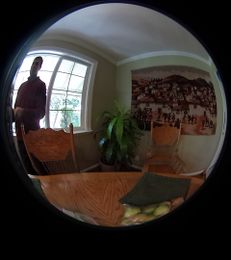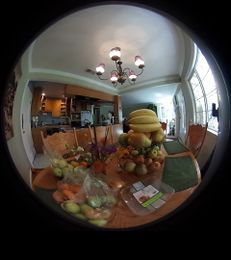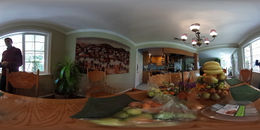Difference between revisions of "Example Fisheye To Equirectangular"
From BoofCV
Jump to navigationJump to searchm |
m |
||
| Line 9: | Line 9: | ||
Equirectangular images are a common way to encode a full 360 view. They are typically generated by combining multiple images together. This example demonstrates how to combine two fisheye camera view from the 360 camera into a single equirectangular view. | Equirectangular images are a common way to encode a full 360 view. They are typically generated by combining multiple images together. This example demonstrates how to combine two fisheye camera view from the 360 camera into a single equirectangular view. | ||
Example File: [https://github.com/lessthanoptimal/BoofCV/blob/v0. | Example File: [https://github.com/lessthanoptimal/BoofCV/blob/v0.38/examples/src/boofcv/examples/calibration/ExampleFisheyeToEquirectangular.java ExampleFisheyeToEquirectangular.java] | ||
Concepts: | Concepts: | ||
| Line 23: | Line 23: | ||
<syntaxhighlight lang="java"> | <syntaxhighlight lang="java"> | ||
/** | /** | ||
* Demonstrates how to combine multiple images together into a single view. | * Demonstrates how to combine multiple images together into a single view. A 360 camera was used to generate | ||
* the two input fisheye images. | * the two input fisheye images. Each camera has been calibrated independently and the extrinsics between the two | ||
* cameras is assume to be known. | * cameras is assume to be known. Because of how the fisheye image is modeled a mask is required to label pixels | ||
* outside the FOV that should not be considered. | * outside the FOV that should not be considered. | ||
* | * | ||
| Line 33: | Line 33: | ||
/** | /** | ||
* Creates a mask telling the algorithm which pixels are valid and which are not. | * Creates a mask telling the algorithm which pixels are valid and which are not. The field-of-view (FOV) of the | ||
* camera is known so we will use that information to do a better job of filtering out invalid pixels than | * camera is known so we will use that information to do a better job of filtering out invalid pixels than | ||
* it can do alone. | * it can do alone. | ||
| Line 97: | Line 97: | ||
FMatrixRMaj adjR = ConvertRotation3D_F32.eulerToMatrix(EulerType.XYZ, GrlConstants.F_PI/2,0,0,null); | FMatrixRMaj adjR = ConvertRotation3D_F32.eulerToMatrix(EulerType.XYZ, GrlConstants.F_PI/2,0,0,null); | ||
// Rotation from the front camera to the back facing camera. | // Rotation from the front camera to the back facing camera. | ||
// This is only an approximation. | // This is only an approximation. Should be determined through calibration. | ||
FMatrixRMaj f2b = ConvertRotation3D_F32.eulerToMatrix(EulerType.ZYX,GrlConstants.F_PI,0,0,null); | FMatrixRMaj f2b = ConvertRotation3D_F32.eulerToMatrix(EulerType.ZYX,GrlConstants.F_PI,0,0,null); | ||
| Line 105: | Line 105: | ||
CommonOps_FDRM.mult(f2b,adjR,frontToBack.R); | CommonOps_FDRM.mult(f2b,adjR,frontToBack.R); | ||
// add the camera and specify which pixels are valid. | // add the camera and specify which pixels are valid. These functions precompute the entire transform | ||
// and can be relatively slow, but generating the equirectangular image should be much faster | // and can be relatively slow, but generating the equirectangular image should be much faster | ||
alg.addCamera(frontToBack,distort0, mask0 ); | alg.addCamera(frontToBack,distort0, mask0 ); | ||
Latest revision as of 09:14, 12 July 2021
Equirectangular images are a common way to encode a full 360 view. They are typically generated by combining multiple images together. This example demonstrates how to combine two fisheye camera view from the 360 camera into a single equirectangular view.
Example File: ExampleFisheyeToEquirectangular.java
Concepts:
- Spherical View
- Fisheye Cameras
- Camera calibration
Related Examples:
Example Code
/**
* Demonstrates how to combine multiple images together into a single view. A 360 camera was used to generate
* the two input fisheye images. Each camera has been calibrated independently and the extrinsics between the two
* cameras is assume to be known. Because of how the fisheye image is modeled a mask is required to label pixels
* outside the FOV that should not be considered.
*
* @author Peter Abeles
*/
public class ExampleFisheyeToEquirectangular {
/**
* Creates a mask telling the algorithm which pixels are valid and which are not. The field-of-view (FOV) of the
* camera is known so we will use that information to do a better job of filtering out invalid pixels than
* it can do alone.
*/
public static GrayU8 createMask( CameraUniversalOmni model ,
LensDistortionWideFOV distortion , double fov ) {
GrayU8 mask = new GrayU8(model.width,model.height);
Point2Transform3_F64 p2s = distortion.undistortPtoS_F64();
Point3D_F64 ref = new Point3D_F64(0,0,1);
Point3D_F64 X = new Point3D_F64();
p2s.compute(model.cx,model.cy,X);
for (int y = 0; y < model.height; y++) {
for (int x = 0; x < model.width; x++) {
p2s.compute(x,y,X);
if( Double.isNaN(X.x) || Double.isNaN(X.y) || Double.isNaN(X.z)) {
continue;
}
double angle = UtilVector3D_F64.acute(ref,X);
if( Double.isNaN(angle)) {
continue;
}
if( angle <= fov/2.0 )
mask.unsafe_set(x,y,1);
}
}
return mask;
}
public static void main(String[] args) {
// Path to image data and calibration data
String fisheyePath = UtilIO.pathExample("fisheye/theta");
// load the fisheye camera parameters
CameraUniversalOmni model0 = CalibrationIO.load(new File(fisheyePath,"front.yaml"));
CameraUniversalOmni model1 = CalibrationIO.load(new File(fisheyePath,"back.yaml" ));
LensDistortionWideFOV distort0 = new LensDistortionUniversalOmni(model0);
LensDistortionWideFOV distort1 = new LensDistortionUniversalOmni(model1);
ImageType<Planar<GrayF32>> imageType = ImageType.pl(3,GrayF32.class);
InterpolatePixel<Planar<GrayF32>> interp = FactoryInterpolation.createPixel(0,255, InterpolationType.BILINEAR,
BorderType.ZERO, imageType);
ImageDistort<Planar<GrayF32>,Planar<GrayF32>> distort =
FactoryDistort.distort(false,interp, imageType);
//This will create an equirectangular image with 800 x 400 pixels
MultiCameraToEquirectangular<Planar<GrayF32>> alg = new MultiCameraToEquirectangular<>(distort,800,400,imageType);
// this is an important parameter and is used to filter out falsely mirrored pixels
alg.setMaskToleranceAngle(UtilAngle.radian(0.1f));
GrayU8 mask0 = createMask(model0,distort0,UtilAngle.radian(182)); // camera has a known FOV of 185 degrees
GrayU8 mask1 = createMask(model1,distort1,UtilAngle.radian(182)); // the edges are likely to be noisy,
// so crop it a bit..
// Rotate camera axis so that +x is forward and not +z and make it visually pleasing
FMatrixRMaj adjR = ConvertRotation3D_F32.eulerToMatrix(EulerType.XYZ, GrlConstants.F_PI/2,0,0,null);
// Rotation from the front camera to the back facing camera.
// This is only an approximation. Should be determined through calibration.
FMatrixRMaj f2b = ConvertRotation3D_F32.eulerToMatrix(EulerType.ZYX,GrlConstants.F_PI,0,0,null);
Se3_F32 frontToFront = new Se3_F32();
frontToFront.setRotation(adjR);
Se3_F32 frontToBack = new Se3_F32();
CommonOps_FDRM.mult(f2b,adjR,frontToBack.R);
// add the camera and specify which pixels are valid. These functions precompute the entire transform
// and can be relatively slow, but generating the equirectangular image should be much faster
alg.addCamera(frontToBack,distort0, mask0 );
alg.addCamera(frontToFront,distort1, mask1 );
// Load fisheye RGB image
BufferedImage buffered0 = UtilImageIO.loadImage(fisheyePath,"front_table.jpg");
Planar<GrayF32> fisheye0 = ConvertBufferedImage.convertFrom(
buffered0, true, ImageType.pl(3,GrayF32.class));
BufferedImage buffered1 = UtilImageIO.loadImage(fisheyePath,"back_table.jpg");
Planar<GrayF32> fisheye1 = ConvertBufferedImage.convertFrom(
buffered1, true, ImageType.pl(3,GrayF32.class));
List<Planar<GrayF32>> images = new ArrayList<>();
images.add( fisheye0 );
images.add( fisheye1 );
alg.render(images);
BufferedImage equiOut = ConvertBufferedImage.convertTo(alg.getRenderedImage(),null,true);
ShowImages.showWindow(equiOut,"Dual Fisheye to Equirectangular",true);
}
}


